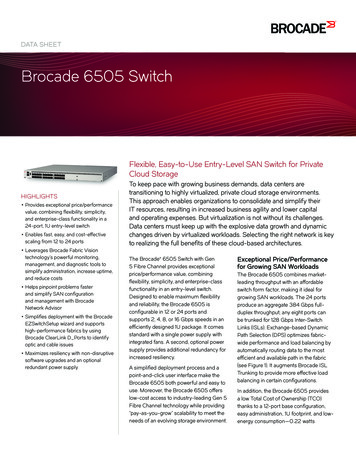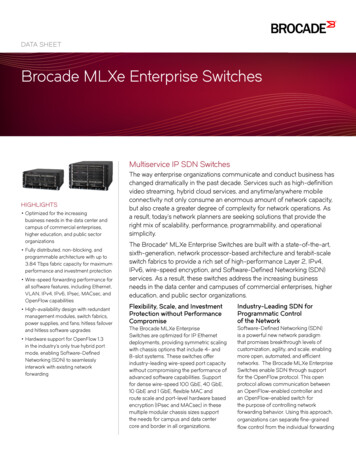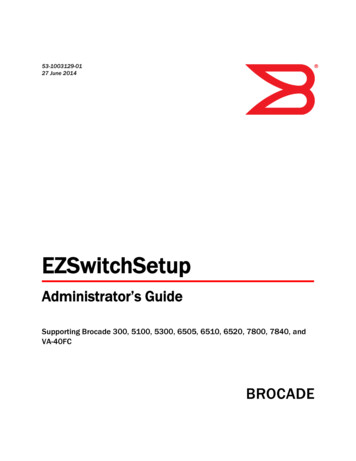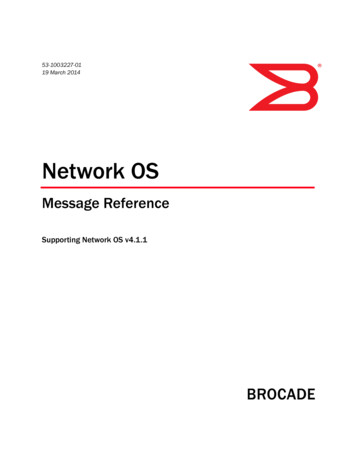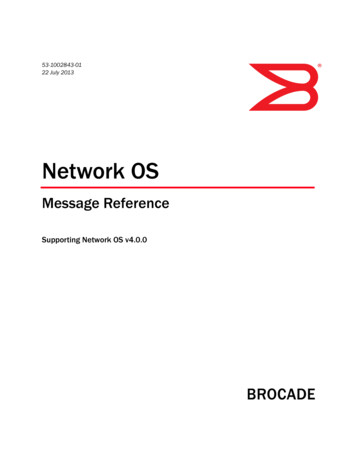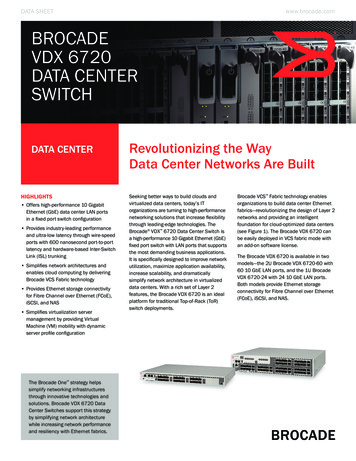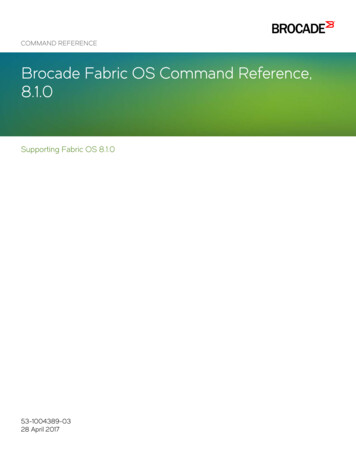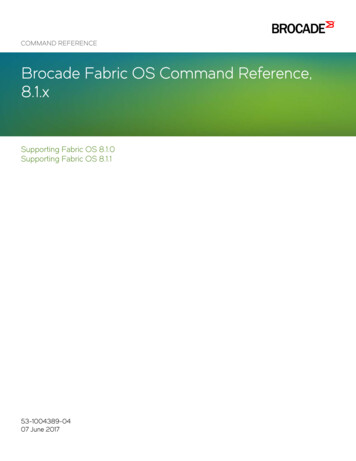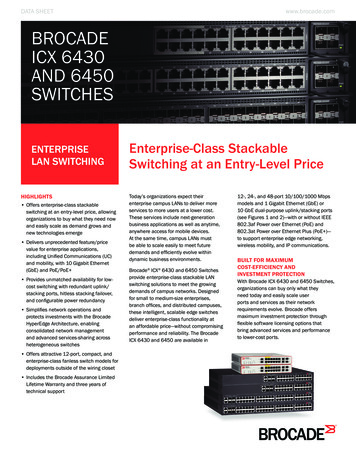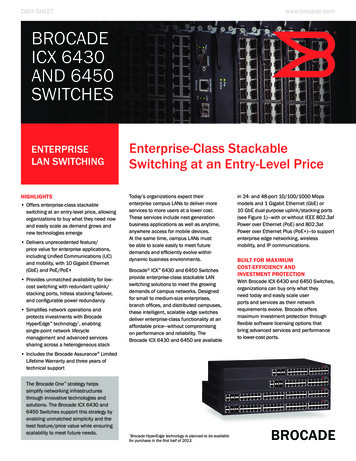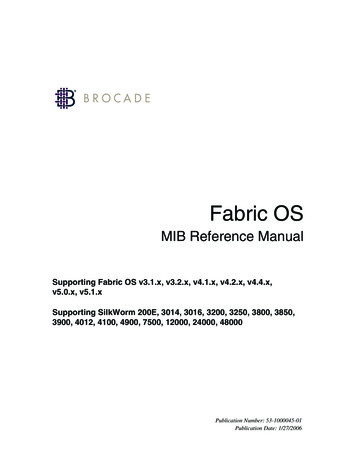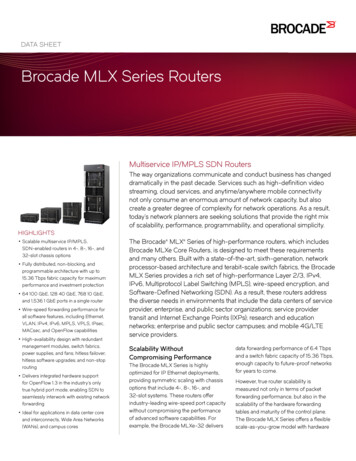
Transcription
Data SheetBrocade MLX Series RoutersMultiservice IP/MPLS SDN RoutersThe way organizations communicate and conduct business has changeddramatically in the past decade. Services such as high-definition videostreaming, cloud services, and anytime/anywhere mobile connectivitynot only consume an enormous amount of network capacity, but alsocreate a greater degree of complexity for network operations. As a result,today’s network planners are seeking solutions that provide the right mixof scalability, performance, programmability, and operational simplicity.Highlights Scalable multiservice IP/MPLS,SDN-enabled routers in 4-, 8-, 16-, and32-slot chassis options Fully distributed, non-blocking, andprogrammable architecture with up to15.36 Tbps fabric capacity for maximumperformance and investment protection 64 100 GbE, 128 40 GbE, 768 10 GbE,and 1,536 1 GbE ports in a single router Wire-speed forwarding performance forall software features, including Ethernet,VLAN, IPv4, IPv6, MPLS, VPLS, IPsec,MACsec, and OpenFlow capabilities High-availability design with redundantmanagement modules, switch fabrics,power supplies, and fans; hitless failover;hitless software upgrades; and non-stoprouting Delivers integrated hardware supportfor OpenFlow 1.3 in the industry’s onlytrue hybrid port mode, enabling SDN toseamlessly interwork with existing networkforwarding Ideal for applications in data center coreand interconnects, Wide Area Networks(WANs), and campus coresThe Brocade MLX Series of high-performance routers, which includesBrocade MLXe Core Routers, is designed to meet these requirementsand many others. Built with a state-of-the-art, sixth-generation, networkprocessor-based architecture and terabit-scale switch fabrics, the BrocadeMLX Series provides a rich set of high-performance Layer 2/3, IPv4,IPv6, Multiprotocol Label Switching (MPLS), wire-speed encryption, andSoftware-Defined Networking (SDN). As a result, these routers addressthe diverse needs in environments that include the data centers of serviceprovider, enterprise, and public sector organizations; service providertransit and Internet Exchange Points (IXPs); research and educationnetworks; enterprise and public sector campuses; and mobile 4G/LTEservice providers.Scalability WithoutCompromising PerformanceThe Brocade MLX Series is highlyoptimized for IP Ethernet deployments,providing symmetric scaling with chassisoptions that include 4-, 8-, 16-, and32-slot systems. These routers offerindustry-leading wire-speed port capacitywithout compromising the performanceof advanced software capabilities. Forexample, the Brocade MLXe-32 deliversdata forwarding performance of 6.4 Tbpsand a switch fabric capacity of 15.36 Tbps,enough capacity to future-proof networksfor years to come.However, true router scalability ismeasured not only in terms of packetforwarding performance, but also in thescalability of the hardware forwardingtables and maturity of the control plane.The Brocade MLX Series offers a flexiblescale-as-you-grow model with hardware
Brocade SDN Controller andBrocade MLX SeriesThe Brocade MLX Series operatesseamlessly under the Brocade SDNController. This controller is a qualityassured edition of the OpenDaylightcontroller code supported by anestablished networking provider andits leaders within the OpenDaylightcommunity.Forwarding Information Base (FIB)capacity options in a wide range ofinterface modules supporting up to 2.4million IPv4 routes or 1.8 million IPv6routes. In addition, the robust control planehas been proven in thousands of missioncritical deployments around the globe.SDN-Enabled ProgrammaticControl of the NetworkSoftware-Defined Networking (SDN)is a powerful new network paradigmdesigned for the world’s mostdemanding networking environmentsand promises breakthrough levels ofcustomization, scale, and efficiency.The Brocade MLX Series enables SDNby supporting the OpenFlow protocol,which allows communication between anOpenFlow controller and an OpenFlowenabled router. Using this approach,organizations can control their networksprogrammatically, transforming thenetwork into a platform for innovationthrough new network applicationsand services.The Brocade MLX Series supportsOpenFlow 1.3 in its innovative hybrid portmode, allowing simultaneous deploymentof traditional switching or routing withOpenFlow on a single port. This uniquecapability provides a pragmatic path toSDN by enabling network operators tointegrate OpenFlow into existing networks,giving them the programmatic controloffered by SDN for specific flows whilethe remaining traffic is routed as before.Brocade hardware support for OpenFlowenables organizations to apply thesecapabilities at scale with support for up to128,000 flows per chassis and line-rateperformance for 100 Gigabit Ethernet(GbE), 40 GbE, and 10 GbE networks.Designed for Non-StopNetworkingDesigned to enable reliable convergedinfrastructures and support missioncritical applications, the Brocade MLXSeries features advanced redundantswitch fabric architecture for very highavailability. The architecture helps ensurethat the system continues to operate at2peak performance even in the case ofa switch fabric card failure. In the highlyunlikely case of additional fabric failures,the advanced architecture allows thesystem to continue operating in a gracefuldegradation mode, where the systemtunes its performance to the remainingfabric capacity.The advanced fabric architecture iscomplemented by comprehensivehardware redundancy for themanagement modules, power supplies,and cooling system. In addition, theBrocade NetIron operating system offershitless management failover for IPv4and IPv6 with Open Shortest Path First(OSPF), IS-IS and IP multicast Non-StopRouting, and Border Gateway Protocol(BGP) Graceful Restart capabilities—aswell as hitless (in-service) softwareupgrades to further enhance both systemavailability and overall network availability.With LDP Graceful Restart, MPLS trafficloss is minimized if there is an interruptionon the network. To maintain continuousoperations in data centers and metronetworks, the innovative Brocade MultiChassis Trunking (MCT) feature providesfast link and node failover protectionwhile simultaneously maximizing networkutilization. For example, MCT supportsactive/standby redundancy for VPLSand VLL pseudowires, providing flexibleoptions for redundancy in networkdesigns that interconnect multiple datacenters. For increased redundancy andfunctionality, dynamic Layer 3 routingover MCT is also supported.Advanced Capabilities for aBroad Range of ApplicationsThe Brocade MLX Series provides awide range of capabilities to supportadvanced applications and services in themost demanding network environments,including Wide Area Network (WAN), datacenter, and campus.The routers enable scalable and resilientLayer 2 Metro Ethernet services thatcomply with the Metro Ethernet Forum(MEF) specifications for Ethernet PrivateLine (EPL), Ethernet Virtual Private Line(EVPL), and Ethernet LAN (E-LAN).
Complementing Layer 2 Metro Ethernetcapabilities is a powerful suite of MPLScapabilities and services, includingMPLS-TE, Fast ReRoute (FRR), MPLSVirtual Leased Line (VLL), Virtual PrivateLAN Service (VPLS), BGP/MPLS VPNs(MPLS Layer 3 VPNs), and DynamicInter-VRF. Routing over VPLS providesLayer 3 forwarding functionality onthe VPLS endpoints, thus simplifyingmanagement and operations by allowinga single access point for both switchingand routing applications. This is ideal forinter-data center connectivity and VirtualMachine (VM) migration in the cloud.The combination of Layer 2/3 featuresand advanced MPLS capabilities enablesthe routers to function in the datacenter core and connect geographicallydistributed data centers using standardsbased technology such as VPLS. Withinthe data center, advanced networkresiliency features, such as MCT, eliminatethe need for spanning tree while enablingefficient usage of network resourcesthrough active-active load balancing.Data Privacy WithoutCompromising NetworkPerformanceThe Brocade MLX 4-port 10 GbEIPsec module for Brocade MLXe CoreRouters provides inline IPsec encryptioncapabilities at wire speed, ensuringdata privacy without compromisingperformance or complicating deploymentmodels. With support for four additionalports of 10 GbE/1 GbE (combo) and fourports of 1 GbE, it supports an industryleading capacity of more than 44 Gbpsencrypted traffic per half-slot module andup to 128 IPsec ports of 10 GbE in a singleBrocade MLXe system. The inline portsfor IPsec deliver unmatched performanceby requiring no service module to beused, freeing up slots in the chassis tobe used for other routing applications.This programmability enables one ofthe strongest cryptographic suites forIPsec—Suite B— available in hardware ofthe Brocade MLXe Series. FFor additionalsecurity, the module supports IEEE802.1AE (MACsec), which provides 128bit Layer 2 hop-by-hop encryption forLocal Area Network (LAN) use cases.The Brocade MLX 20-port 10/1 GbEmodule for the Brocade MLXe CoreRouter provides inline IEEE 802.1AE(MACsec), which provides 128-bit MAClayer hop-by-hop encryption for LANuse cases, with up to 640 10 GbE/1 GbEMACsec ports per chassis.Scalable and Intelligent NetworkVisibilityThe Brocade MLXe Core Router providesvisibility capabilities to non-disruptivelyand transparently tap into a productionnetwork with no loss in performance. Itfilters and extracts relevant network trafficbased on the rules configured staticallyor dynamically on it. Industry-leadingport density, low latency, high throughput,and scalability make the Brocade MLXerouter a powerful solution for carrierclass environments. By implementingnetwork visibility with Brocade MLXerouters, network operators can increaseanalytics into network data and traffic,process captured data to evaluate networkand application conditions, and generateactionable metrics and reports used fornetwork planning.Simplified Service ManagementDelivering effective MPLS services onCarrier Ethernet infrastructure requiresfast fault identification and isolation. TheBrocade MLX Series supports MPLSLabeled Switch Path (LSP) ping andtrace route features to isolate any MPLSrelated connectivity issues. In addition,it supports all the capabilities of IEEE802.1ag (Connectivity Fault Management),including Connectivity Check Messages,Loopback Message/Response, andLinkTrace Message/Response.IEEE 802.1ag, in conjunction with theMPLS OAM features, provides thecapabilities to monitor, isolate, and identifyconnectivity problems and reduce thetime to repair business VPN services. Forperformance management on CarrierEthernet infrastructure, the Brocade MLXSeries supports Y.1731 to measure roundtrip delay and jitter characteristics betweentwo points in the network. To diagnoselink layer connectivity issues, the routersalso support the IEEE 802.3ah LinkOAM feature.In addition, the Brocade MLX Seriessupports standards-based sFlow trafficmonitoring technology, which providesunprecedented visibility into networkusage. Integrated into the line modulehardware, the sFlow technology enablesthe monitoring of high-speed links withoutimpacting performance.To simplify the manageability of Ethernetservices, the Brocade MLX Seriesleverages Brocade Network Advisor,an application that unifies networkmanagement for all Brocade products.Brocade Network Advisor provides theeasy-to-use MPLS Manager, which canhelp configure, monitor, and manageVPLS and Virtual Leased Line (VLL)services across networks that arebased on Brocade routers. In addition,the sFlow-based technology utilizedby Brocade Network Advisor reducesnetwork downtime with proactivemonitoring, traffic analysis, and reporting.Enabling Green OperationsAlthough adding routers to addressbandwidth shortage might initially solvethe capacity problem, it does so at theexpense of the environment and theopportunity to reduce energy and spacecosts. Any new solution that fails to reduceenergy consumption is only a partialanswer to the problem. Eachnew generation of line modules inthe Brocade MLX Series consumesless energy per bit than the previousgeneration while significantly increasingthroughput per module. In addition, therouters provide industry-leading portdensities for 1 GbE, 10 GbE, 40 GbE,and 100 GbE interfaces, efficientlyconsolidating more services andcollapsing network layers.Brocade MLX Series InterfaceModulesThe Brocade MLX Series provides awide range of leading-edge Ethernetmodules for 1 GbE, 10 GbE, 40 GbE, and100 GbE that enable organizations to usea single platform for many applications.For more information about thesemodules, see Tables 1 and 2.3
Brocade Global ServicesBrocade Global Services has theexpertise to help organizations buildscalable, efficient cloud infrastructures.Leveraging 15 years of expertise instorage, networking, and virtualization,Brocade Global Services delivers worldclass professional services, technicalsupport, and education services,enabling organizations to maximizetheir Brocade investments, acceleratenew technology deployments, andoptimize the performance of networkinginfrastructures.Affordable Acquisition OptionsBrocade Capital Solutions helpsorganizations easily address their ITrequirements by offering flexible networkacquisition and support alternatives.Organizations can select from purchase,lease, Brocade Network Subscription,and Brocade Subscription Plus options toalign network acquisition with their uniquecapital requirements and risk profiles.To learn more, visit www.Brocade.com/CapitalSolutions.Table 1. Brocade MLX Series interface modules.Versions SupportedInterface Module-M-X24 1 GbE RJ45 24 1 GbE Fiber 48 1 GbE MRJ21 4 10 GbE 8 10 GbE 24 10 GbE-DM 20 10 GbE 20 1 GbE (upgradable to 10 GbE) 4 10 GbE IPsec 4 40 GbE 2 100 GbE CFP2 2 100 GbE CFP* 1 100 GbE CFP* *Denotes full-slot module, all other interface modules are half-slot.Table 2. Supported route table scalability for Brocade MLX interface modules.Maximizing InvestmentsTo help optimize technology investments,Brocade and its partners offer completesolutions that include professionalservices, technical support, and education.For more information, contact a Brocadesales partner or visit www.brocade.com.4-X2Interface Module VersionSupported Route Table Scalability-DMUp to 256,000 IPv4 routesUp to 64,000 IPv6 routes-MUp to 512,000 IPv4 routesUp to 256,000 IPv6 routes-XUp to 1 million IPv4 routesUp to 240,000 IPv6 routes-X2Up to 2.4 million IPv4 routesUp to 1.8 million IPv6 routes
Key Features4-, 8-, 16-, and 32-slot systems formaximum deployment versatilityUp to 9.5 billion packets per second routingperformance with non-blocking 15.36 Tbpsdata capacityIdeal for demanding, high-densityenvironments with up to: 64 100 GbE ports per system 128 40 GbE ports per system 768 10 GbE ports per system 1,536 1 GbE ports per systemComprehensive, wire-speed, dual-stackIPv4/IPv6 routing support based on theBrocade Multi-Service IronWare OS: High-performance, robust routing usingForwarding Information Base (FIB)programming in hardwareOSPF/OSPFv3, IS-IS/IS-IS RIP/RIPng,for IPv6, and BGP-4/BGP-MP for IPv6Multi-VRF routing for supporting Securevirtual routing applications over nonMPLS backbones VRRP and VRRP-EConnecting IPv6 islands over IPv4 MPLS usingIPv6 Provider Edge (6PE) routers6VPEIPv6 multitenancy to the edge ofenablingthe cloud 127-bit IPv6 interface addressesIndustry-leading scalability up to:* 10 million BGP routes 2.4 million IPv4 routes in hardware (FIB) 1.8 million IPv6 routes in hardware (FIB) 153,600 multicast routes 2,000 BGP peers per system2,000 BGP/MPLS VPNs and up to 1 millionVPN routes48,000VLLs per system 16,000VPLSinstances and up to 1 million VPLS MAC addressesand 64,000RSVP-TE LSPsVLANs and up to 2 million MAC 4,094addressesEqual Cost Multi-Path Large-scale(ECMP); up to 32 paths for unicast andmulticastSoftware-Defined Networking (SDN):1.3: QoS (for metering and OpenFlowenqueue), Group Table (select andfast failover), QinQ (TAG type autorecognition), Active-Standby Controller,IPv6, Transport Layer Security (TLS) 1.2(controller interface)OpenFlow in hybrid port mode Brocadewith support for sFlow, IP, and MPLS/VPLS (uplinks) with protected VLAN foradditional flexibility Up to 128,000 flows supported12-tuple (Layer 2 and Layer 3) Truematching for a diverse set of applicationsIndustry-leading performance for MPLSservices, providing several service choices: IP over MPLS, IPv6 over MPLS (6PE),IPv6 Layer 3 VPNs (6VPE), MPLS overGRE, Virtual Leased Line (VLL), VirtualPrivate LAN Service (VPLS), BGP/MPLSVPN, Multi-VRF, routing over VPLS,Max VPLS LSP Load Balance Scale forLER, RSVP TE Link Metric for CSPFComputation, RSVP Auto-Bandwidth withAbsolute ThresholdComprehensive MPLS signaling and pathcalculation algorithms for both trafficengineered and non-traffic-engineeredapplications:OSPF-TE, IS-IS-TE, RSVP-TE, LDP,CSPF, LDP over RSVP, Point-toMultipoint (P2MP) RSVP-TE LSPFRR (detour, bypass) and hot MPLSstandby paths for traffic protectionSuperior high-availability design: Redundant management modules Redundant switch fabricspower supplies and cooling RedundantsystemLayer 2/3 failover with stateful HitlessOSPF IS-IS and BGP Graceful Restart(in-service) software upgrades with HitlessGraceful RestartAdvanced QoS:Hierarchical Quality of Service (H-QoS): Supportsup to four levels of hierarchy—port, logical port (optional), customer(optional), and serviceand outbound two-rate three Inboundcolor traffic policers with accounting Eight distinct priority levelssupport for congestion WREDmanagement and precedence dropping(tunable via configuration)for hybrid queue servicing Supportdisciplines: Mixed, Strict Priority, andWeighted Fair QueuingComprehensive hardware-based securityand policies:2/3 ACLs (both inbound and Layeroutbound)ACL accounting (both inbound Granularand outbound) Hardware-based packet filteringPolicy-Based Routing Hardware-based(PBR) Unicast Reverse Path Forwarding (uRPF) IPv4/IPv6 Receive ACLssFlow Layer 2–7 traffic Extensivemonitoring for IPv4, IPv6, and MPLSservices IPv6 ACL-Based Rate Limiting ACL Editingnetwork access control using Port-based802.1x or MAC port security Root guard and BPDU guardmulticast, and unknown unicast Broadcast,rate limits ARP inspection for static entries Multi-port Static ARP and Static MACSuite B Algorithm IP-layer 256-bitencryption 128-bit MAC-layer encryptionAdvanced Carrier-grade Ethernet services:to reuse VLAN-ID on each port Abilityusing the Brocade Ethernet ServiceInstance (ESI) framework MPLS Layer 2 VPN services IEEE 802.1ad Provider Bridges IEEE 802.1ah Provider Backbone Bridges802.1ag Connectivity Fault IEEEManagementITU Y.1731 OAM functions and mechanismsfor Ethernet-based networksComprehensiveset of Layer 2 control protocols: BrocadeMRP/MRP-II, VSRP,RSTP, MSTP, and ITU G.8032 EthernetRing Protection (ERP version 1 and 2)Trunking with support for Multi-Chassisup to 512 clients (Active/Active mode orActive/Standby mode for Active/Passiveaccess for client ports)E-LINE (EPL and EVPL), E-LAN, and E-TREEsupportProtocoltunneling of Bridge Protocol Data Units (BPDUs) MEF 9, MEF 14, and MEF 21 certificationFull suite of unicast and multicast IPv4 andIPv6 routing protocols:Supported IPv4 protocols include RIP, OSPF,BGP-4, IS-IS, PIM-DM, PIM-SM/SSM, IGMP, BGP-MP for multicast,MSDP, Anycast RP, PIM Multicast ECMP,and RPF ShortcutSupported IPv6 protocols include RIPng, OSPFv3,IS-IS for IPv6, BGP-MP forIPv6 (BGP4 ), PIM-SM/SSM, MLD,VRRPv6, IPv6 Non-Stop Routing (NSR),VRRP-E, PIM Multicast ECMP, and RPFShortcut* Scalability limits depend on configured system parameters, -DM/-X/-X2 module types, licenses, system profile selected, and routing database complexity.5
Brocade MLX Series at a GlanceFeaturesMLXe-4MLXe-8MLXe-16MLXe-32Interface slots481632Switch fabric capacity1.92 Tbps3.84 Tbps7.68 Tbps15.36 TbpsData forwarding capacity1.6 Tbps3.2 Tbps6.4 Tbps12.8 TbpsPacket routing performance1.19 billion pps2.38 billion pps4.75 billion pps9.5 billion ppsMaximum 100 GbE ports8163264Maximum 40 GbE ports163264128Maximum 10 GbE ports96192384768Maximum 1 GbE ports1923847681,536Height (inches/rack units)8.71 in./5RU12.21 in./7RU24.50 in./14RU57.75 in./33RUManagement module redundancy1:11:11:11:1Switch fabric redundancyN 1N 1N 1N 1Power supply redundancy1 11 11 11 1AirflowSide to backSide to backFront to backFront to backMLXe-4MLXe-8MLXe-16MLXe-32Maximum DC power consumption (W)2,0834,0607,10714,232Maximum AC power consumption (W)(100-240 VAC)2,0834,0607,10714,232Maximum thermal output (BTU/HR)7,10813,85824,25548,575Brocade MLX Series Power SpecificationsBrocade MLX Series Physical Specifications6ModeDimensionsWeightBrocade MLXe-417.20 in. W 8.71 in. H 23.0 in. D(43.69 cm 22.12 cm x 58.42 cm)117 lb (53 kg)Brocade MLXe-817.20 in. W 12.21 in. H 24.0 in. D(43.69 cm 31.01 cm 60.96 cm)171 lb (78 kg)Brocade MLXe-1617.20 in. W 24.47 in. H 24.18 in. D(43.69 cm 62.15 cm 61.42 cm)351 lb (159 kg)Brocade MLXe-3217.45 in. W 57.75 in. H 26.88 in. D(44.32 cm 146.69 cm 68.28 cm)505 lb (229 kg)
Brocade MLX Series SpecificationsIEEE Compliance802.3-2005 CSMA/CD Access Method and Physical Layer Specifications 802.3ab 1000BASE-T 802.3ae 10 Gigabit Ethernet802.3u 100BASE-TX, 100BASE-T4, 100BASE-FX Fast Ethernet at 100Mbps with Auto-Negotiation802.3xFlow Control 802.3z 1000BASE-X Gigabit Ethernet over fiber optic at 1 Gbps 802.3ad Link Aggregation 802.3ah Ethernet in the First Mile 802.1Q Virtual Bridged LANs 802.1D MAC Bridges 802.1w Rapid STP 802.1s Multiple Spanning TreesProvider Bridges; partial support: port-based and S-tagged 802.1adservice interface 802.1ag Connectivity Fault Management (CFM) 8023.ba 100 Gigabit Ethernet 802.1ab Link Layer Discovery Protocol 802.1ah Provider Backbone Bridging 802.1ae MAC Security standardOSPFIS-ISITU Compliance Y.1731 OAM functions and mechanisms for Ethernet-based networks G.8032 Ethernet Ring Protection (ERP version 1 and 2)RFC ComplianceBGPv4 RFC 1745 OSPF Interactions RFC 1772 Application of BGP in the Internet RFC 1997 Communities and AttributesRFC 2385 BGP Session Protection via TCP MD5 RFC 2439 Route Flap Dampening RFC 2918 Route Refresh Capability RFC 3392 Capability AdvertisementRFC 3682 Generalized TTL Security Mechanism,for eBGP Session Protection RFC 4271 BGPv4 RFC 4273 BGP-4 MIB RFC 4456 Route Reflection4486 Sub Codes for BGP Cease RFCNotification Message RFC 4724 Graceful Restart Mechanism for BGPRFC 4893 BGP Support for Four-octet AS NumberSpace RFC 5065 BGP4 Confederations5291 Outbound Route Filtering Capability RFCfor BGP-45396 Textual Representation of RFCAutonomous System (AS) NumbersRFC 5668 4-Octect AS specific BGP ExtendedCommunityRIPIPv4 Multicast RFC 2328 OSPF v2 RFC 3101 OSPF NSSA RFC 1745 OSPF Interactions RFC 1765 OSPF Database Overflow RFC 1850 OSPF v2 MIB2154 OSPF w/Digital Signature(Password, RFCMD-5) RFC 2370 OSPF Opaque LSA Option RFC 3137 OSPF Stub Router Advertisement RFC 3630 TE Extensions to OSPF v23623 Graceful OSPF Restart (helper RFCmode)4222 Prioritized Treatment of Specific RFCOSPF Version 2 RFC 5250 OSPF Opaque LSA option1195 Routing in TCP/IP and Dual RFCEnvironments1142 OSI IS-IS Intra-domain RFCRouting Protocol RFC 3277 IS-IS Blackhole Avoidance RFC 5120 IS-IS Multi-Topology Support RFC 5301 Dynamic Host Name Exchange RFC 5302 Domain-wide Prefix Distribution5303 Three-Way Handshake for IS-IS RFCPoint-to-PointRFC 5304 IS-IS Cryptographic Authentication(MD-5)5306 Restart Signaling for ISIS RFC(helper mode) RFC 1058 RIP v1 RFC 2453 RIP v2 RFC 1812 RIP Requirements RFC 1122 Host Extensions RFC 1112 IGMP v1 RFC 2236 IGMP v2 RFC 2362 PIM-SM RFC 3376 IGMP v3 RFC 3569 Overview of SSM RFC 3618 MSDP RFC 3973 PIM-DM RFC 4610 Anycast RP using PIM RFC 4611 MSDP Deployment Scenarios RFC 4760 BGP-MP
General ProtocolsQoS8 RFC 768 UDP RFC 791 IP RFC 792 ICMP RFC 793 TCP RFC 826 ARP RFC 854 TELNET RFC 894 IP over Ethernet RFC 903 RARP RFC 906 TFTP Bootstrap RFC 950 Subnet RFC951 BootP RFC 1027 Proxy ARP RFC 1042 Standard for The Transmission of IP RFC 1166 Internet Numbers RFC 1122 Host Extensions for IP Multicasting RFC 1191 Path MTU Discovery RFC 1256 IRDP RFC 1340 Assigned Numbers RFC 1519 CIDR RFC 1542 BootP Extensions RFC 1591 DNS (client) RFC 1812 Requirements for IPv4 Routers1858 Security Considerations for IP RFCFragment Filtering RFC 2131 BootP/DHCP Helper2578 Structure of Management RFCInformation Version 2 RFC 2784 Generic Routing Encapsulation3021 Using 31-Bit Prefixes on IPv4 Point RFCto-Point Links RFC 3768 VRRP4001 Textual Conventions for Internet RFCNetwork Addresses RFC 4950 ICMP Extensions for MPLS RFC 4459 MTU and Fragmentation RFC 2474 DiffServ Definition2475 An Architecture for Differentiated RFCServices RFC 2597 Assured Forwarding PHB Group RFC 2697 Single Rate Three Color Marker RFC 2698 A Two-Rate Three-Color Marker RFC 3246 An Expedited Forwarding PHBOtherIPv6 Core RFC 2474 DiffServ Definition2475 An Architecture for Differentiated RFCServices RFC 2597 Assured Forwarding PHB Group RFC 2697 Single Rate Three Color Marker RFC 2698 A Two-Rate Three-Color Marker RFC 3246 An Expedited Forwarding PHB RFC 1354 IP Forwarding MIB RFC 1757 RMON Groups 1, 2, 3, 9 RFC 2068 HTTP RFC 2665 Ethernet Interface MIB2784 Generic Routing Encapsulation RFC(GRE) RFC 2865 RADIUS RFC 2863 Interfaces Group MIB RFC 3176 sFlow RFC 4087 IP Tunnel MIB RFC 4133 Entity MIB RFC 4293 - IP MIB RFC 5905 NTP Version 4 RFC 4741 NETCONF (Partial) RFC 5961 TCP Security5880 Bidirectional Forwarding RFCDetection (BFD)1887 IPv6 unicast address allocation RFCarchitecture RFC 1981 IPv6 Path MTU Discovery RFC 2375 IPv6 Multicast Address Assignments2450 Proposed TLA and NLA RFCAssignment Rules RFC 2460 IPv6 Specification2462 IPv6 Stateless Address—Auto RFCConfiguration2464 Transmission of IPv6 over Ethernet RFCNetworks RFC 2471 IPv6 Testing Address allocation RFC 2711 IPv6 Router Alert Option3587 IPv6 Global Unicast—Address RFCFormat4193 Unique Local IPv6 Unicast RFCAddresses RFC 4291 IPv6 Addressing Architecture RFC 4301 IP Security Architecture RFC 4303 Encapsulation Security Payload RFC 4305 ESP and AH cryptography RFC 4443 ICMPv6 RFC 4552 Auth for OSPFv3 using AH/ESP RFC 4835 Cryptographic Alg. Req. for ESP4816 Neighbor Discovery for IP version 6 RFC(IPv6)
IPv6 RoutingIPv6MulticastIPv6TransitioningMPLS RFC 2080 RIPng for IPv6 RFC 2740 OSPFv3 for IPv6 RFC 5308 Routing IPv6 with IS-IS RFC 2545 Use of BGP-MP for IPv66106 Support for IPv6 Router Advertisements RFCwith DNS Attributes6164 Using 127-Bit IPv6 Prefixes on RFCInter-Router Links2710 Multicast Listener Discovery (MLD) for RFCIPv63810 Multicast Listener Discovery Version 2 RFCfor IPv6 RFC 4601 PIM-SM RFC 4604 IGMPv3 and MLDv2 for SSM RFC 4607 Source-Specific Multicast for IP3056 Connection of IPv6 Domains via RFCIPv4 CloudsRFC 4213 Transition Mechanisms for IPv6 Hosts andRoutersRFCConnecting IPv6 Islands over IPv4 MPLS4798Using IPv6 Provider Edge Routers4659 BGP-MPLS IP Virtual Private Network RFC(VPN) Extension for IPv6 VPN RFC 2205 RSVP v1 Functional Specification RFC 2209 RSVP v1 Message Processing Rules RFC 2702 TE over MPLS2961 RSVP Refresh Overhead Reduction RFCExtensions RFC 3031 MPLS Architecture RFC 3032 MPLS Label Stack Encoding RFC 3037 LDP Applicability RFC 3097 RSVP Cryptographic Authentication RFC 3209 RSVP-TE RFC 3270 MPLS Support of Differentiated Services RFC 3813 MPLS LSR MIB3815 Definition of Managed Objects for the RFCMPLS, LDP4090 Fast Reroute Extensions to RSVP-TE for RFCLSP Tunnels; partial support RFC 4379 OAM4448 Encapsulation methods for transport of RFCEthernet over MPLS networks4461 Signaling Requirements for Point-to RFCMultipoint Traffic-Engineered MPLS Label SwitchedPath(LSR)RFC 4875 Extensions to RSVP-TE for P2MP TE LSPs RFC 5036 LDP Specification RFC 5305 ISIS-TE RFC 5443 LDP IGP Synchronization RFC 5561 LDP Capabilities5712 MPLS Traffic Engineering Soft RFCPreemption RFC 5918 LDP “Typed Wildcard” FEC5919 Signaling LDP Label Advertisement RFCCompletionLayer 3 VPNLayer 2 VPNand PWE3Encryption RFC 3107 Carrying Label Information in BGP-4 RFC 4360 BGP Extended Communities Attribute RFC 4364 BGP/MPLS IP VPNs4365 Applicability Statement for RFCBGP/MPLS IP VPNs RFC 4382 MPLS/BGP Layer 3 VPN MIB4576 Using LSA Options Bit to Prevent RFCLooping in BGP/MPLS IP VPNs (DN Bit)RFC 4577 OSPF as the PE/CE Protocol in BGP/ MPLSIP VPNs RFC 4760 Multiprotocol Extensions for BGP-4 RFC 3343 TTL Processing in MPLS networks4664 Framework for Layer 2 Virtual Private RFCNetworks4665 Service Requirements for Layer 2 RFCProvider-Provisioned Virtual Private Networks RFC 4762 VPLS using LDP SignalingPseudowire Emulation Edge to Edge RFC3985(PWE3) Architecture4447 Pseudowire Setup and Maintenance RFCusing LDP4448 Encapsulation Methods for Transport of RFCEthernet over MPLS Networks5542 Definitions of Textual Conventions for RFCPseudowire (PW) Management5601 Pseudowire (PW) Management RFCInformation Base5996 Internet Key Exchange Protocol Version RFCVersion 2 (IKEv2) RFC 4303 IP Encapsulating Security Payload (ESP) RFC 6379 Suite B Cryptographic Suites for IPsec5903 Elliptic Curve Groups modulo a Prime RFC(ECP Groups) for IKE and IKEv24868 Using HMAC-SHA-256, HMAC RFCSHA-384, and HMAC-SHA-512 with IPsec4754 IKE and IKEv2 Authentication Using the RFCElliptic Curve Digital Signature Algorithm(ECDSA)4106 The Use of Galois/Counter Mode (GCM) RFCin IPsec Encapsulating Security Payload (ESP) RFC 3602 AES with 128-bit keys in CBC mode4806 Online Certificate Status Protocol RFC(OCSP) Extensions to IKEv2 FIPS PUB 186-4 Digital Signature Standard (DSS)Recommendation for Pair-Wise Key SP800-56AEstablishment Schemes Using Discrete
Brocade MLX Series Routers highLightS Scalable multiservice iP/MPLS, SDN-enabled routers in 4-, 8-, 16-, and Brocade MLXe Core Routers, is designed to meet these requirements 32-slot chassis options Fully distributed, non-blocking, and programmable architecture with up to 15.36 tbps fabric capacity for maximum
